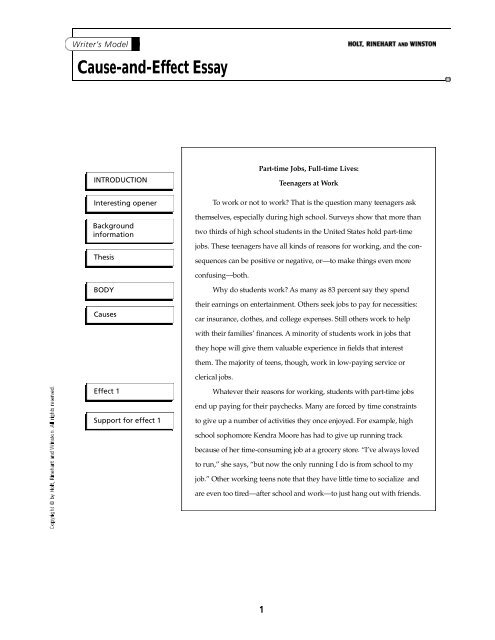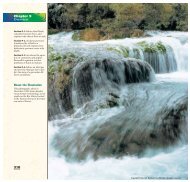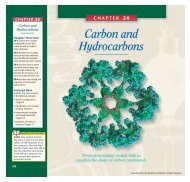Ca u s e - a n d - Ef fect Essay
Ca u s e - a n d - Ef fect Essay
Ca u s e - a n d - Ef fect Essay
Create successful ePaper yourself
Turn your PDF publications into a flip-book with our unique Google optimized e-Paper software.
Wr i t e r’s Model<br />
<strong>Ca</strong> u s e - a n d - <strong>Ef</strong> <strong>fect</strong> <strong>Essay</strong><br />
INTRODUCTION<br />
Interesting opener<br />
Background<br />
information<br />
Thesis<br />
BODY<br />
<strong>Ca</strong>uses<br />
<strong>Ef</strong><strong>fect</strong> 1<br />
Support for ef<strong>fect</strong> 1<br />
Part-time Jobs, Full-time Lives:<br />
1<br />
Teenagers at Wo r k<br />
To work or not to work? That is the question many teenagers ask<br />
themselves, especially during high school. Surveys show that more than<br />
two thirds of high school students in the United States hold part-time<br />
jobs. These teenagers have all kinds of reasons for working, and the con-<br />
sequences can be positive or negative, or—to make things even more<br />
c o n f u s i n g — b o t h .<br />
Why do students work? As many as 83 percent say they spend<br />
their earnings on entertainment. Others seek jobs to pay for necessities:<br />
car insurance, clothes, and college expenses. Still others work to help<br />
with their families’ finances. A minority of students work in jobs that<br />
they hope will give them valuable experience in fields that intere s t<br />
them. The majority of teens, though, work in low-paying service or<br />
clerical jobs.<br />
Whatever their reasons for working, students with part-time jobs<br />
end up paying for their paychecks. Many are forced by time constraints<br />
to give up a number of activities they once enjoyed. For example, high<br />
school sophomore Kendra Moore has had to give up running track<br />
because of her time-consuming job at a grocery store. “I’ve always loved<br />
to run,” she says, “but now the only running I do is from school to my<br />
job.” Other working teens note that they have little time to socialize and<br />
a re even too tired—after school and work—to just hang out with friends.
Wr i t e r’s Model<br />
<strong>Ca</strong> u s e - a n d - <strong>Ef</strong> <strong>fect</strong> <strong>Essay</strong> co n ti nu ed<br />
<strong>Ef</strong><strong>fect</strong> 2<br />
Support for ef<strong>fect</strong> 2<br />
Additional support for<br />
ef<strong>fect</strong> 2<br />
<strong>Ef</strong><strong>fect</strong> 3<br />
Support for ef<strong>fect</strong> 3<br />
Most studies show that students who work more than fifteen<br />
hours a week not only have lower participation rates in extracurricular<br />
activities but also get lower grades than students who work fewer hours<br />
or not at all (Stern). Students who work and try to keep up their<br />
extracurricular activities must juggle those activities and their school-<br />
work to try to maintain a balance. Sam Linares, a high school junior, has<br />
had to learn this juggling act. Sam is a varsity basketball player, is<br />
involved with student government, and is a member of a choir that<br />
meets four days a week. He also works at a local fast-food re s t a u r a n t<br />
ten nights every month. “Since I started working, I’ve had to schedule<br />
every minute of my life,” says Sam. “At first, my grades really slipped,<br />
but after a while I became more organized. Luckily, my grades are<br />
i m p roving again, and I’m still keeping up with my other activities.”<br />
Not all consequences of working part time during the high school<br />
years are detrimental, however. There are benefits as well, and, like the<br />
drawbacks, these depend on the individual student and the type of job<br />
he or she has. Most jobs re q u i re teenagers to meet adult goals and to<br />
function in adult situations. Managers and colleagues can offer<br />
positive role models to students, and the “real-world” demands of<br />
punching a clock and learning to work well with others teach re s p o n s i-<br />
bility and self-discipline. Research conducted in the late 1990s shows that<br />
students who work fewer than fifteen hours a week have more positive<br />
attitudes about work and higher future earning potential (Stern).<br />
2
Wr i t e r’s Model<br />
<strong>Ca</strong> u s e - a n d - <strong>Ef</strong> <strong>fect</strong> <strong>Essay</strong> co n ti nu ed<br />
CONCLUSION<br />
Restatement of thesis<br />
To work or not to work? Perhaps every teen thinking about leap-<br />
ing into the job market should consider this question: Why work?<br />
Having more money for new clothes and movie tickets isn’t as impor-<br />
tant as having time for family, friends, and school. On the other hand,<br />
learning new skills in a part-time job can increase self-esteem and moti-<br />
vate students to learn more in school and to budget their time more<br />
e ff e c t i v e l y. Teens who are considering a leap into the world of work<br />
should weigh their reasons for wanting a job against the consequences<br />
of having one. As Sam Linares can tell you, it’s a lot easier to juggle<br />
things that are balanced.<br />
3
Wr i t e r’s Model<br />
L i tera ry Re s ea rch Pa per co n ti nu ed<br />
Works Cited<br />
L i n a res, Sam. Personal interview. 19 April 2000.<br />
M o o re, Kendra. Personal interview. 19 April 2000.<br />
Stern, David. “Learning and Earning: The Value of Working for<br />
Urban Students.” ERIC/CUE Digest N o v. 1997. 19 April 2000<br />
< h t t p : / / w w w. t e x s h a re . e d u / o v i d w e b / o v i d w e b . c g i ? T = s e l C i t &<br />
F = a l l & A = d i s p l a y & S T = 4 & R = 2 & t o t a l C i t = 4 7 & D = e rc z & S = P H M K<br />
B K J P L A G P C P > .<br />
4
Wr i t e r’s Guide<br />
<strong>Ca</strong> u s e - a n d - <strong>Ef</strong> <strong>fect</strong> <strong>Essay</strong><br />
Definition<br />
A c a u s e - a n d - e <strong>fect</strong> essay examines the causes and ef<strong>fect</strong>s of an event or situation. A good cause-and-eff e c t<br />
essay clearly explains the relationship between actions and reactions in a specific context.<br />
Many cause-and-ef<strong>fect</strong> essays use the stru c t u re illustrated in the framework below. Print this framework<br />
and use it as a guide when you write your own cause-and-ef<strong>fect</strong> essay.<br />
Framework Directions and Explanations<br />
Introduction<br />
■ Get your readers intere s t e d .<br />
■ P rovide background<br />
i n f o rm a t i o n .<br />
■ Include a clear thesis.<br />
Body<br />
■ P resent the causes and/or<br />
e f<strong>fect</strong>s of your topic in a clear<br />
s e q u e n c e .<br />
■ S u p p o rt the causes and/or<br />
e f<strong>fect</strong>s with adequate detail.<br />
Conclusion<br />
■ Remind your readers of your<br />
thesis and bring your essay<br />
to a close.<br />
Listen up Your introduction should make readers want<br />
to keep reading your essay. Try starting with a thoughtp<br />
rovoking question, an interesting quotation, or an<br />
a n e c d o t e .<br />
The back story Give readers background information that<br />
helps them understand why your topic is important.<br />
Announce the main event Your thesis statement should<br />
clarify the purpose of your essay.<br />
Telling the tale Make sure your analysis pro g resses in<br />
logical ord e r. Use chronological order to analyze a causal<br />
chain. Otherwise, use order of importance—from most<br />
important to least important or vice versa.<br />
Support your statements Use statistics, facts, examples, and<br />
expert opinions to provide supporting details for each of<br />
your statements.<br />
The curtain call Restate your main points briefly. End your<br />
explanation on a high note with a thought-provoking<br />
statement, a question, or a pre d i c t i o n .<br />
5
















